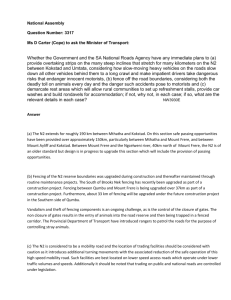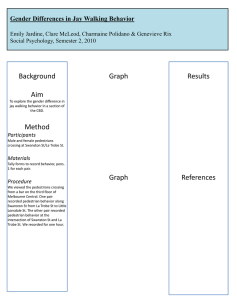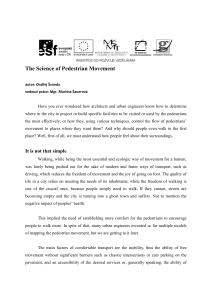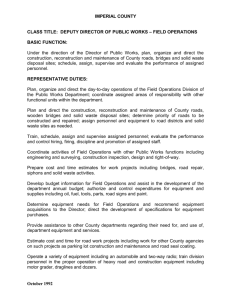2. policy guidelines - Main Roads Western Australia
advertisement
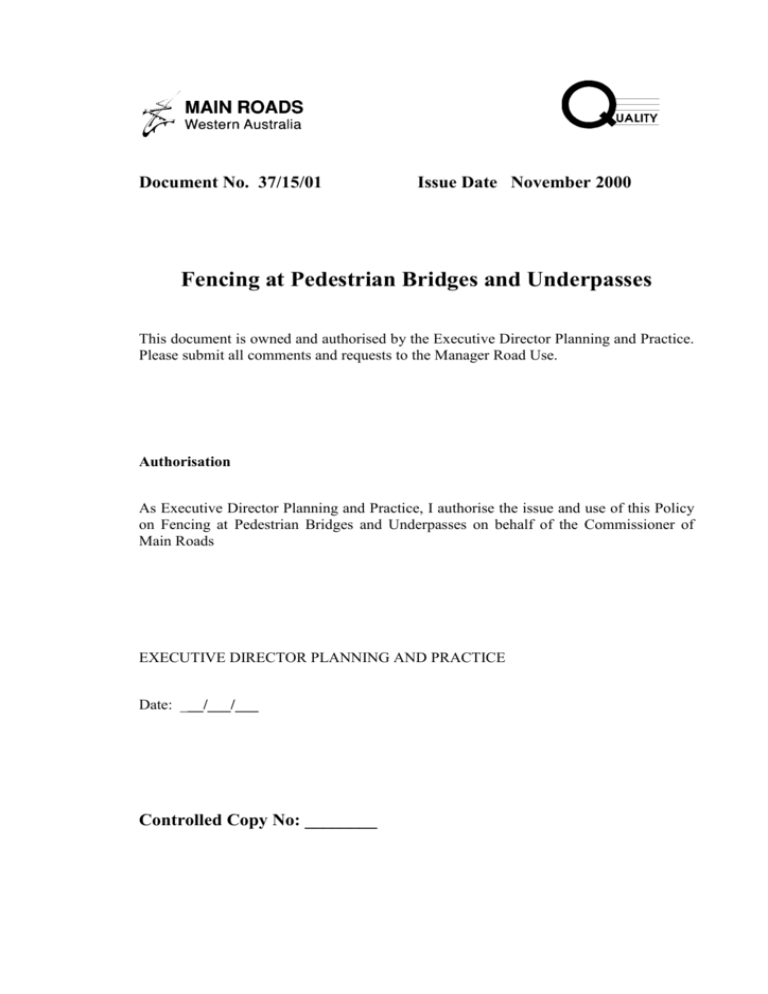
Document No. 37/15/01 Issue Date November 2000 Fencing at Pedestrian Bridges and Underpasses This document is owned and authorised by the Executive Director Planning and Practice. Please submit all comments and requests to the Manager Road Use. Authorisation As Executive Director Planning and Practice, I authorise the issue and use of this Policy on Fencing at Pedestrian Bridges and Underpasses on behalf of the Commissioner of Main Roads EXECUTIVE DIRECTOR PLANNING AND PRACTICE Date: ___/___/___ Controlled Copy No: ________ Fencing at Pedestrian Bridges and Underpasses Preface: This Policy and accompanying Guidelines were developed by Main Roads Western Australia’s Planning and Practice Directorate with the assistance of experienced advice from both internal and external sources. They are a consequence of the removal of a traffic regulation that disallowed pedestrians crossing roads at grade within 120 metres of a pedestrian bridge or underpass, and to enhance pedestrian safety generally. Regulation changes were a result of the adoption of Australian Road Rules by Government and integration of those rules into the Road Traffic Code 2000. Comments from users on this document should be addressed to the Road Safety Manager as follows: Brian Kidd Road Safety Manager Main Roads Western Australia Don Aitken Centre Waterloo Crescent EAST PERTH WA 6004 Phone: Fax: Email: MAIN ROADS Western Australia (08) 9323 4500 (08) 9323 4547 (See Fax Back) brian.kidd@mrwa.wa.gov.au Fencing at Pedestrian Bridges and Underpasses Document 37/15/01 Issue 1 (July 2000) Page 2 of 9 REVISION STATUS RECORD Section No. Page No. Latest Revision No. Revision Description/Reference Authorised by ………………………………………….………. …../…../….. Executive Director Planning and Practice MAIN ROADS Western Australia Fencing at Pedestrian Bridges and Underpasses Document 37/15/01 Issue 1 (July 2000) Page 3 of 9 Fax Back Fax No: (08) 9323 4547 Please photocopy or detach this sheet and fax, post or deliver To: Mr Brian Kidd Road Use Branch Main Roads Western Australia Waterloo Crescent EAST PERTH WA 6004 Phone: (08) 9323 4500 Fax: (08) 9323 4547 Email: brian.kidd@mrwa.wa.gov.au Please provide your comments on suggested changes or modifications on the Fencing at Pedestrian Bridges and Underpasses Policy and Guidelines. Attach additional sheets if needed Name: …………………………………………………….. Main Roads Directorate/Branch Unit: ……………………. Date:……………….. or Organisation: ……………………………………………….. Telephone:…………. MAIN ROADS Western Australia Fencing at Pedestrian Bridges and Underpasses Document 37/15/01 Issue 1 (July 2000) Page 4 of 9 SECTION CONTENTS 1. POLICY ............................................................................................................................................... 6 1.1 1.2 1.3 1.4 1.5 2. PAGE PURPOSE ........................................................................................................................................... 6 SCOPE ............................................................................................................................................... 6 BACKGROUND................................................................................................................................... 6 DEFINITIONS ..................................................................................................................................... 6 POLICY STATEMENT ......................................................................................................................... 7 POLICY GUIDELINES ..................................................................................................................... 8 2.1 2.2 2.3 CRITERIA .......................................................................................................................................... 8 APPLICATION OF POLICY & GUIDELINES .......................................................................................... 9 REFERENCES ..................................................................................................................................... 9 MAIN ROADS Western Australia Fencing at Pedestrian Bridges and Underpasses Document 37/15/01 Issue 1 (July 2000) Page 5 of 9 1. 1.1 POLICY Purpose The purpose of this document is to detail Main Roads WA’s policy for installing fencing adjacent to pedestrian bridges and underpasses. 1.2 Scope This policy is to be applied in conjunction with the policy guidelines to provide a consistent approach to the provision of fencing at all pedestrian bridges and underpasses on Highways and Main Roads in Western Australia. 1.3 Background Pedestrian bridges and underpasses are primarily provided to assist pedestrians crossing busy roads in relative safety, while minimising disruption to road traffic. However, they have practical limitations. For instance, pedestrians have to travel considerably further to use these facilities than they would otherwise do by crossing roads at grade. For many pedestrians, the risk of being hit by a vehicle while crossing roads is not perceived to be high whereas travelling the extra distance to use a facility is seen as an unnecessary waste of time and energy. Apart from extra travel distance and time taken to use bridges and underpasses some pedestrians, particularly the disabled, find that ramp slopes are too steep to negotiate. A further issue that mitigates the use of pedestrian underpasses is fear of being accosted or assaulted. While some of these problems are addressed by design standards and location decisions, many pedestrians continue to cross roads at-grade. A traffic regulation that was specifically included in the Road Traffic Code to legally deter pedestrians from crossing at-grade existed for many years. However, in the absence of sustained Police enforcement, pedestrians continued to cross at-grade. Consequently, many carriageways have been fenced adjacent to these facilities to compel pedestrians to use them, although this has not been consistently applied. Since traffic regulations making it an offence to cross within 120 metres of pedestrian bridges and underpasses have been removed, it is appropriate that a consistent approach to fencing be put into place. This document addresses the circumstances where fencing is required. 1.4 Definitions Road Traffic Code: Regulations under the provisions of the Road Traffic Act 1974. Footpath: An area open to and used by the public that is designated for, or has one of its main uses, use by pedestrians. Shared path: An area open to and used by the public (except a separated footpath) that is designated for or has one of its main uses, use by both pedestrians and bicycles. MAIN ROADS Western Australia Fencing at Pedestrian Bridges and Underpasses Document 37/15/01 Issue 1 (July 2000) Page 6 of 9 Separated footpath: 1.5 A length of footpath that is separated into two parts longitudinally – one part for the exclusive use of pedestrians and the other by bicycles, and designated as such by signs. Policy Statement Main Roads WA will install pedestrian fencing adjacent to pedestrian bridges and underpasses along Highways and Main Roads, where appropriate, to prevent pedestrians crossing nearby and to direct them to cross at the bridge or underpass, or a suitable crossing point. MAIN ROADS Western Australia Fencing at Pedestrian Bridges and Underpasses Document 37/15/01 Issue 1 (July 2000) Page 7 of 9 2. 2.1 POLICY GUIDELINES Criteria The criterion for fencing to be installed adjacent to pedestrian bridges and underpasses along roads under the care and control of the Commissioner of Main Roads is as follows. (a) General Requirements Fencing shall be installed only where pedestrian safety is at risk by crossing at-grade and the fencing will not impose additional, unacceptable restrictions on vehicles parking on the carriageway, or access to public transport, e.g buses. Fencing shall not impose unreasonable restrictions on access by people with disabilities. The fencing shall be installed between the carriageway and the pedestrian pathway (footpath, shared path or separated footpath). Alternatively, on dual carriageways where crossing movements by visually impaired pedestrians are infrequent and the median width is sufficient, fencing may be installed within the median. Where fencing is installed between a path and a carriageway, kerbside No Stopping prohibition for vehicles shall be installed along the carriageway between the extremities of the fencing (including any gap in the fencing at the bridge or underpass). The length of fencing shall be determined by the circumstances. It shall extend 100 metres either side of the bridge or underpass, unless circumstances make this impractical and a lesser length is appropriate, i.e. to enable access to intersections, median openings, driveways, bus and taxi stands, or at-grade pedestrian facilities. Particular attention is to be given to the height and placement of the fence and to the materials used. It should not obscure drivers’ view of other traffic and pedestrians, (particularly children), and it should be constructed of materials and in a manner that would minimise the potential for injury to pedestrians and vehicle occupants in the event of a crash. I.e. fences with top rails are not allowed within the clear zone and requirements for the use of chain mesh in lieu of higher standard fencing materials such as weldmesh and balustrading should be examined. General design principles for fencing in urban areas is discussed in the ‘Draft Guide to the Design of Fencing and Walls’. When fencing is proposed in the vicinity of bus or other public transport stops, it shall be designed and installed in close consultation with Transperth Service Planners and Bus Stop Coordinator, as well as with the Senior Transit Engineer at the Metropolitan Infrastructure Directorate of the Department of Transport. (b) Direction Signs to Indicate Crossing Point Signs to direct pedestrians to the bridge or underpass shall be installed in accordance with AS 1742 Part 10, if the facility is not clearly visible to pedestrians. They shall be provided near the commencement of the fencing, at the crossing access point and other locations as appropriate to ensure pedestrians are directed to the bridge or underpass. MAIN ROADS Western Australia Fencing at Pedestrian Bridges and Underpasses Document 37/15/01 Issue 1 (July 2000) Page 8 of 9 2.2 Application of Policy & Guidelines The Policy and Guidelines shall be applied where an investigation indicates that pedestrians are crossing roads adjacent to a pedestrian bridge or underpass and their safety is at risk or traffic efficiency is unacceptably compromised. 2.3 References AS1742 Manual of Uniform Traffic Control Devices, Part 10: Pedestrian Control and Protection. Draft Guide to the Design of Fencing and Walls: Road and Traffic Engineering Branch. MAIN ROADS Western Australia Fencing at Pedestrian Bridges and Underpasses Document 37/15/01 Issue 1 (July 2000) Page 9 of 9
